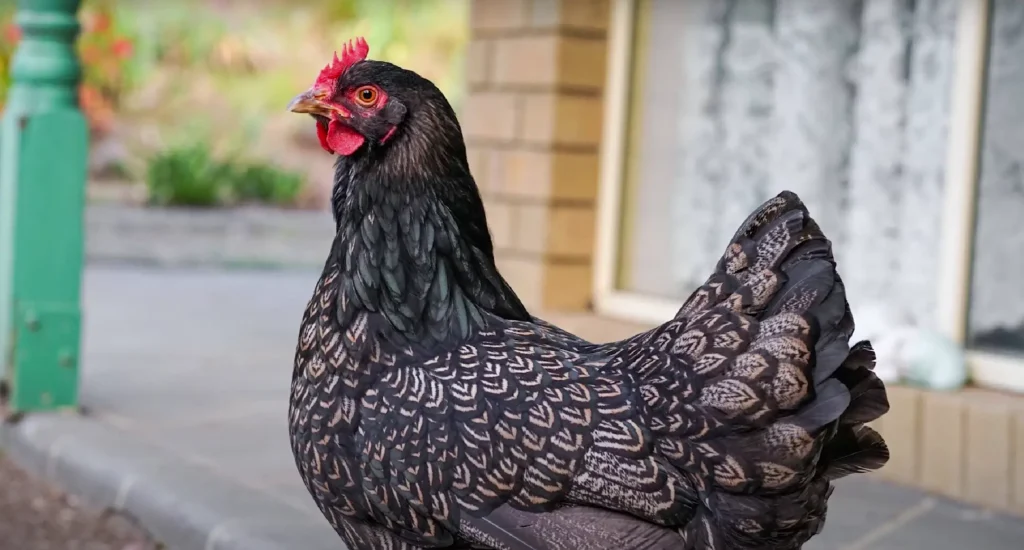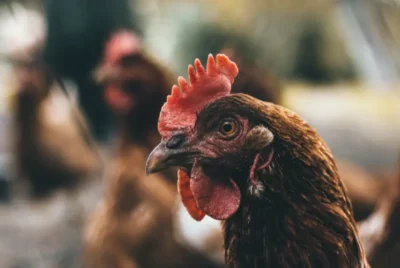Discover the Charm of Barnevelder Chickens
If you’re pondering the addition of Barnevelder chickens to your flock, you’re probably drawn to their reputation for laying mesmerizing dark brown eggs and their easygoing nature.
Here, we unveil the allure of Barnevelders, from their standout aesthetic to their reliable egg production and congenial personality—all of which make them an exemplary dual-purpose breed.
Origins and Evolution of the Barnevelder Breed
The Barnevelder breed has a rich and exciting history. Originating in the Barneveld region of the Netherlands, these birds were developed through a careful crossbreeding process involving local Dutch chickens and the Langshan, Plymouth Rock, and Rhode Island Red breeds.
This meticulous crossbreeding was initiated to produce a bird that lays distinct chocolate brown eggs and possesses good meat qualities, making them an excellent dual-purpose breed.
The Barnevelder’s popularity can be attributed to several factors, including:
- Their ability to lay dark brown eggs, which was in high demand in early 20th-century England
- Their hardiness and meat qualities
- The official standardization of the breed in 1923 solidified their status in the poultry world.
Unveiling the Barnevelder’s Unique Look

Standing out in any flock, the Barnevelder chickens have unique double-laced feather pattern. The outer band of their feathers is usually black, while the inner band varies from brown to reddish-brown, a characteristic trait of the Barnevelder.
Moreover, they possess a classy rectangular body shape with a U-shaped back, fitting the standard for a medium-sized breed. The Barnevelder hens typically weigh around 6-7 pounds, while the roosters weigh about 7-8 pounds.
The Barnevelder roosters, particularly, are striking with their melanistic black-breasted red coloration. Their stunning appearance is one of the many reasons why this breed is not just loved by backyard chicken keepers but also revered in exhibitions, even the roosters.
Barnevelder Colors and Patterns
While the double-laced brown is the most common variety of the Barnevelder, they aren’t limited to this single color. Barnevelders come in a variety of colors and patterns that add diversity to your flock, including the double-laced Barneveld and:
- white
- black
- silver-laced
- blue double-laced
- blue splash
- golden-laced
- brown-laced
- silver-black double-laced
These various color patterns make each lovely bird unique, adding charm to your backyard flock of beautiful birds, including dual-purpose birds.
The double-laced brown Barnevelder sometimes referred to as chestnut, is particularly sought after. This color pattern gives these chickens:
- a deep reddish-brown color
- feathers outlined in double black lacing on their wings, breast, back, and tail
- heads adorned with a black hue that radiates a cool green shine
Understanding the Barnevelder Breed Standard
The breed standard for the Barnevelder varies by country, with different standards emphasizing different traits. However, the common thread among all these standards is the breed’s distinctive appearance. The Barnevelder breed standard focuses on the bird’s appearance, size, and feather pattern, making them a favorite among poultry enthusiasts.
You should acknowledge that the Barnevelder bantams aren’t officially recognized in the breed standard. However, the double-laced Barnevelders are classified as ‘continental’ by the American Poultry Association, and this variety is acknowledged.

Characteristics of Barnevelder Chicken
Docile and Friendly Temperament
Beyond their appearance and egg-laying prowess, Barnevelder chickens are cherished for their gentle and friendly nature. They have a calm and docile temperament, making them easy to handle and suitable for families with children. Their approachable demeanor and peaceful disposition make them a favorite among poultry enthusiasts.
Limited Flying Abilities
Unlike some chicken breeds that are skilled fliers, Barnevelders cannot fly. They have short wings and are generally poor flyers. This characteristic is advantageous for backyard keepers who want chickens that are less likely to fly over fences or escape their enclosures, ensuring that they stay close to home.
Broodiness and Nurturing Instincts
Barnevelder hens may occasionally go broody, but they are not extremely difficult to break from this behavior if needed. They have nurturing instincts and make excellent mothers when they do decide to sit on a clutch of eggs. Moreover, even Barnevelder roosters can help raise and nurture baby chicks, demonstrating their caring and protective nature.

The Social Life of a Barnevelder Chicken
Beyond their stunning appearance, the Barnevelder breed has a personality to match. Known for their friendly and calm demeanor, they make excellent pets, particularly for families with children. Their affectionate nature and gentle vibe make them a joy to be around, providing endless entertainment and companionship to their keepers.
One of the standout traits of Barnevelders is how well they get along with other chickens. Their gentle and non-aggressive nature allows them to integrate well with other breeds, making them a great addition to any mixed flock.
Barnevelder Chicken Egg Laying Performance and Traits

Barnevelder hens are moderately good egg layers, producing about 180-200 eggs in a year, with peak production during spring and summer. The eggs they lay are unique and appealing, making them perfect for your egg basket:
- Not too big, not too small
- Loved by those who prefer their eggs to be special and tasty
- Over the years, the color of the eggs has changed from the original chocolate shade to varying shades of brown, adding to their charm.
Barnevelder Egg Color
The Barnevelder’s eggs are as diverse as their feather pattern. They lay eggs in different shades of brown, ranging from light to really dark, and some might even have speckles or be cream-colored. This variety in egg color is largely attributed to their genetics, contributing to the allure of the breed.
Most chicken owners love the darkest shades of Barnevelder eggs, as they resemble rich chocolate in color. This distinct egg color is eye-catching and highly desirable, making Barnevelder eggs a favorite among many.
Egg Production Over the Hen’s Lifetime
Barnevelder hens usually start laying eggs at around 8-10 months old. They continue to produce eggs throughout their life, with an average of 200 eggs per year.
Despite a slight decline in production as they age, Barnevelder hens continue to lay eggs all year round, even during the winter months. This consistent egg production is one of the appealing aspects of this breed, making them a great choice for those looking for a reliable source of eggs.
Read also: 10 Best Laying Chickens for Your Backyard (350 Eggs Per Year)
Caring Tips for Barnevelder Chickens
Raising Barnevelder chickens is a fairly simple task, thanks to their adaptable nature. These birds can thrive in both free-range or confined environments, making them a versatile breed that can adapt to various living arrangements, including being a pet chicken or backyard chickens, with relative ease.
When it comes to their diet, Barnevelder chickens are not fussy eaters. They can do well on different types of foods, consuming between 2.9oz (80g) and 4.2oz (120g) of chicken feed every day. From eight weeks old until they start laying eggs, they should be fed a diet with 20% protein. Additionally, these chickens are cold hardy, making them suitable for colder climates.
Coop Requirement For Your Barnevelder Flock
Whether you plan on keeping your Barnevelder chickens in a coop or allowing them to free-range, proper housing is essential. You should give each chicken about 4 square feet of space in the coop, with medium- to coarse-grained sand serving as the best bedding for them.
A dry and roofed environment is important to keep their feet and legs dry. While they are adaptable to a free-range setup, they do require shelter to rest and take cover when needed.
Common Halth Issues and Prevention
Despite their generally robust health, Barnevelder chickens are more susceptible to Marek’s Disease, a highly contagious form of Herpesvirus that can cause nervous system inflammation, tumor development, and paralysis. To prevent this, I recommend vaccinating the baby chicks right after hatching.
Keeping a close eye on your Barnevelder flock for any signs of illness or injury is essential. Common symptoms of Marek’s Disease are:
- pale combs
- weight loss
- dehydration
- diarrhea
- difficulty moving
- head shaking
- unusual pupils
- sensitivity to light
- improper growth
- vision problems

How To Integrate Barnevelders with Other Chickens
If you’re thinking of adding Barnevelder chickens to your existing flock, there are a few things to consider. Due to their gentle nature, it’s important to choose other birds that are calm and of similar size and age to avoid any potential bullying.
Despite their gentle nature, Barnevelders are usually able to integrate easily with different chicken breeds. However, it’s important to monitor their behavior closely during the initial introduction phase. Look out for signs of stress or bullying, such as:
- quieter behavior
- aggression
- missing feathers
- a decline in egg-laying.
Barnevelder Meat Qualities
Aside from their stunning appearance and egg-laying abilities, Barnevelder chickens are also good for their meat qualities. The roosters typically weigh around 7-8 lbs and the hens around 5-6 lbs when fully grown, providing a decent amount of meat.
The meat of the Barnevelder chicken have a rich, distinct flavor, different from other chicken breeds. This, coupled with their egg-laying abilities, makes them a true dual-purpose breed, offering both quality eggs and meat to their keepers.
Read also: 10 Essential Tips for Raising Meat Chickens
Frequently Asked Questions
How long do Barnevelder chickens live?
Barnevelder chickens typically have a lifespan of 6 to 8 years, although some individuals may live longer with proper care and attention to their health. Factors that can influence their lifespan include genetics, diet, living conditions, and overall care.
What is the difference between a Wyandotte and a Barnevelder?
The main differences between a Wyandotte and a Barnevelder are the comb type and the shape of the body, especially the tail. Barnevelders have a single comb, while Wyandottes have a rose comb, and Barnevelders have a longer body with a less spread tail. It’s all about the comb type and body shape!
What is the difference between a Barnevelder and a Bielefelder?
The main difference between a Barnevelder and a Bielefelder is that the Barnevelder is a Dutch breed of chicken, while the Bielefelder is a German breed of chicken.
Summary
With their striking appearance, friendly nature, and unique egg-laying abilities, Barnevelder chickens offer a multitude of benefits to their keepers. Whether you’re a seasoned poultry enthusiast or a beginner looking to start a backyard flock, the Barnevelder breed is a versatile and rewarding choice. Their adaptability, ease of care, and dual-purpose nature make them a truly outstanding breed worth considering.




